Hugo Chavez came to power in 1998 promising a change in the way government was run, with the plight of the poor and a war against corruption as the centerpiece of his campaign platform. More than 10 years and $200 billion in oil revenue later, there is little perceptible change in the effectiveness of social spending in Venezuela, and corruption is arguably as bad, or worse, than it was prior to his election. Yet Chavez remains in power, with ambition to stay there indefinitely, and his brand of 21st century socialism has been exported throughout Latin America. This article examines whether positive economic change has occurred in the Latin American countries that have embraced Chavez's political model.
Real GDP growth has traditionally gyrated - sometimes wildly - in Latin America. Since Chavez was first elected, real GDP has mostly declined in Venezuela, apart from a short period in 2004. Since Morales was elected in 2005 in Bolivia, real GDP has remained steady. Since Correa took office in 2007, Ecuador's real GDP briefly rose, before getting caught up in the global recession. Nicaragua's real GDP has mostly consistently under-performed against the region and the world average, was below zero from 1984-1994, and has been in steady decline since 2004.

Non-socialist countries in Latin America have generally performed better. Although Argentina, Brazil, Chile and Colombia's real GDP growth all gyrated - sometimes wildly - between 1980 and 2008, in general, their rates of growth were higher than the 21st century socialist countries. Like Bolivia, Ecuador and Venezuela, Argentina, Brazil, Chile and Colombia are all resource rich. The primary difference is how they transitioned from military to democratic governments, and how each government managed or mismanaged its fiscal resources.
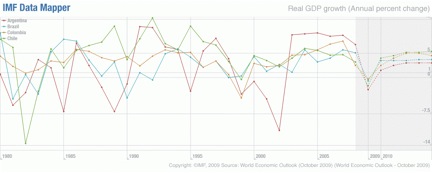
The level of direct investment in the economy in Bolivia, El Salvador, Honduras, and Venezuela from 1980 to 2008 is mixed. The worst performer, by far, is Venezuela, which declined from nearly $6 billion in 1998 to less than $1 billion by 2008. Part of this is due to the anti-foreign investment laws that were passed since Chavez came to power, nationalizations in key sectors, and a reliance on more indigenous forms of investment. In Bolivia, the initial decline in FDI leveled off since Morales modified his nationalization program in the power sector, but investment levels remain depressed compared with levels in the late 1990s. Although investment levels have slowly risen in Honduras since 2002, this trend is likely to be reversed based on the political change that occurred in the country earlier this year. Investment levels in Ecuador have been declining since 2004, and like Nicaragua and Bolivia, have always been under $1 billion per annum.

By contrast, average direct investment levels have risen considerably since the mid-1990s in Argentina, Brazil, Chile and Colombia. Brazil's investment levels has been at least 10 percent since 1996, and even at their low points since that time, the other countries' investment levels has not dropped below $1 billion.
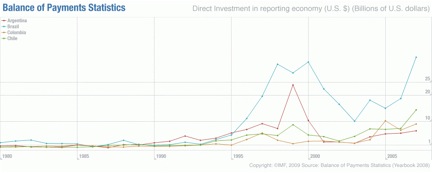
Inflation rates gyrated wildly in Venezuela and Ecuador in the 1980s and 1990s, reaching as high as 100% in Venezuela in 1996 and Ecuador in 2000. It is on the rise again in Venezuela, and is projected by the IMF to approach 50% next year. After reaching incredible highs of more than 11,000 percent in Bolivia and more than 12,000 percent in Nicaragua in the 1980s, inflation has been at more manageable levels since the 1990s, and remains under control in Honduras.
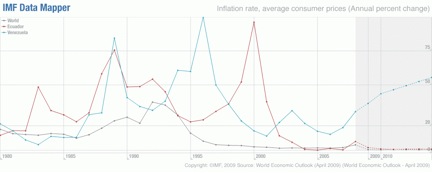
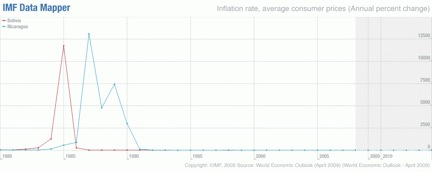
Although Argentina and Brazil experienced periods of hyper-inflation, inflation has been under control in Argentina since 1992 and in Brazil since 1996, and in Chile and Colombia throughout the reporting period.
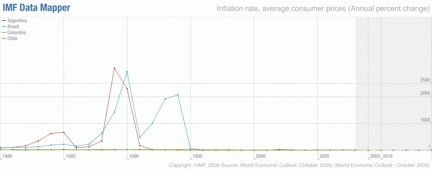
Unemployment remains a persistent problem in most of Latin America, with a contributing factor being high birth rates. As is the case with so many other statistics for the referenced countries, the unemployment rates have tended to lack consistency. Since Chavez came to power, the unemployment rate has been cut in half, from 15% to 7.5%, due, largely, to the swelling ranks of public employees. Ecuador's unemployment rate has been roughly halved, as well, from a high of 14% in 1999 to roughly 7% in 2008. IMF statistics for Bolivia and Nicaragua are incomplete, but the trend lines were rising in both countries in the middle of this decade.
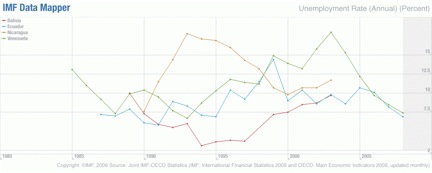
Unemployment remains an issue in Argentina, Brazil, Chile, and Colombia. The unemployment rate in Argentina reached as high as 18% in the early part of this decade, and was reduced to 7.5% in 2008. The worst affected of the four non-socialist countries has been Colombia, whose unemployment rate reached 20% in 2000, but had been reduced to 11% by 2008. Brazil's rate was as high as 10% and Chile's 8% earlier this decade, but were both 7.5% in 2008. Of all of the statistics measured in this study, unemployed poses the most persistent challenge.

In terms of exports, it is no surprise that Venezuela's statistics are quite favorable, given Chavez's emphasis on revitalization of the oil sector. Export income has more than tripled since Chavez came to power. A similar story in Ecuador, where the maturation of the oil sector has resulted in a doubling of export income since 2001. Bolivia's statistics might have been even more favorable if it were not for the nationalizations since 2005. Both Bolivia's and Nicaragua's export statistics are unimpressive, being nearly flat from 1980 to 2003.
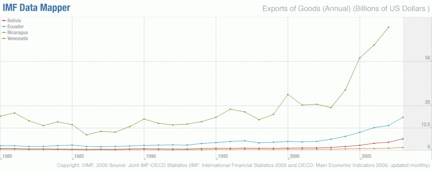
The non-socialist countries being used in this study were certainly not flat since 1986. In the case of Brazil, export income has risen ten-fold, to approximately $200 billion since that time. Argentina's, Chile's, and Colombia's export income all rose dramatically during the period. This coincided with a generally more liberalized trade regime, along with enlightened policy decisions on the part of the region's governments.

Venezuela's jump in exports has been matched by a concurrent rise in imports due to a corresponding rise in foreign exchange levels and domestic demand. The same is true in Bolivia, Ecuador and Nicaragua. That is sustainable as long as export income and consumption levels rise. What countries like Bolivia, Ecuador and Venezuela must address is how rising import levels can be sustained when oil export revenue falls, as has been the case in the past year. In Venezuela's case, expectation levels among the general populace have risen in accordance with oil revenue generation. Chavez has his hands full in managing those expectations since the price of oil was halved a year ago.
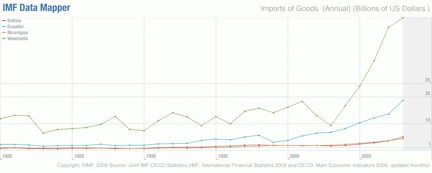
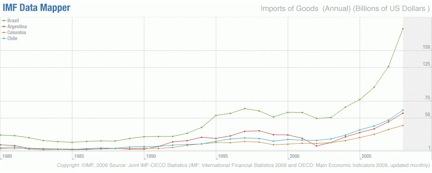
Although the cost of a barrel of oil rose nearly 15-fold between 1998 and 2008, Latin America's socialist petro states generally tended not to benefit from a meaningful rise in foreign exchange reserves until well into the current decade. The additional revenue generated for national budgets in the interim years appears to have evaporated, as the region's petro states squandered much of the wealth that was created. Venezuela's propensity for wild reserve fluctuations persisted for the entire 20-year period being observed - throughout Hugo Chavez's reign as President. For those Latin American countries that do not have petro-based economies, such as Nicaragua, the chronic foreign exchange deficit has continued unabated.

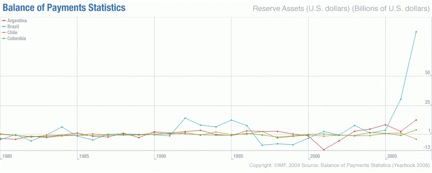
Brazil enjoyed a tremendous rise in its reserve asset position since 2005, largely the result of the spike in oil prices between 2005 and 2008. Its skillful management of its fiscal resources is in stark contrast to Venezuela. The significant new oil discoveries that have been made in the past two years imply that eventually, it will become the dominant hydrocarbon supplier in the region, and may become the new model for social development in the region.
In spite of the avalanche of oil wealth over the past 10 years, the region's petro states have generally failed to invest adequately in local infrastructure or keep pace with the rising levels of expectation among their populations. Chronic mismanagement of indigenous infrastructure, poor planning, and endemic corruption have also contributed to the problem, as has frozen tariff levels for water and power, providing a disincentive to conserve resources, and exacerbating the problem. This has exacerbated the level of frustration among voters and raised question about whether 21st Century Socialism is ultimately any different than any other political movement in terms of rhetoric and deliverables.
In Venezuela, less than a quarter of the $643 million budgeted for electricity infrastructure projects between 2001 and 2005 was actually spent, and less than 10 percent of the additional electricity generating capacity deemed necessary for the country's growing population 10 years ago has been realized. Chavez responded in October 2009 by implementing power and water rationing, and blaming El Nino for the problem. The bottom line is that in spite of all his rhetoric and promises, Chavez has failed to deliver what he promised to his people.
Even when times have been good, Latin America's socialist countries have still failed to deliver meaningful political and economic reforms or effective public spending programs. From an economic perspective, 21st Century Socialism has failed to deliver a meaningfully improved standard of living for most of the people who have embraced Chavez's credo. The global recession has only served to highlight many of the inherent contradictions in Chavez's 'revolution'.
